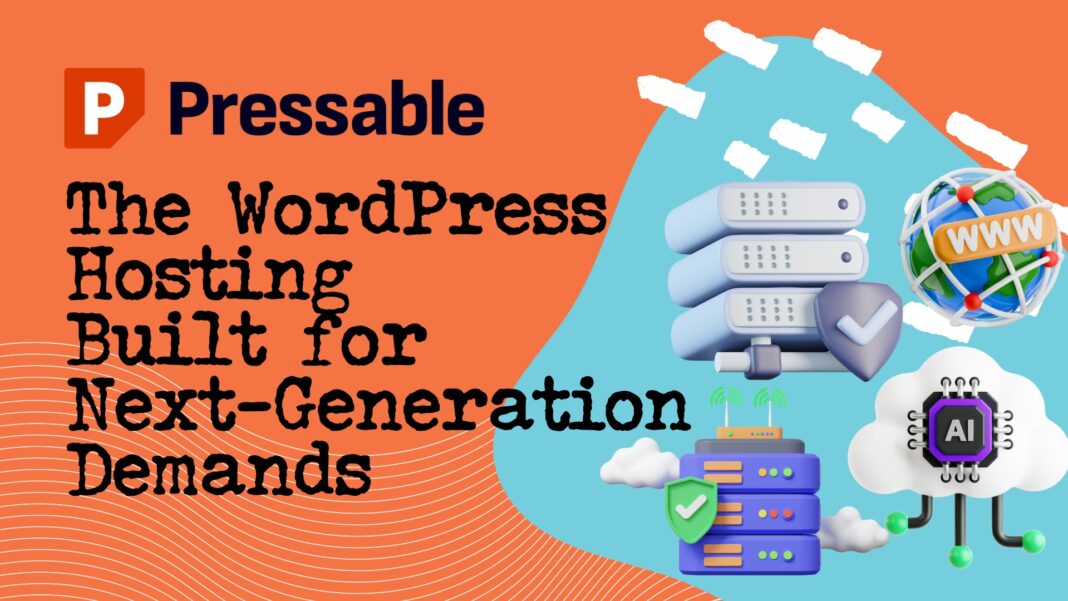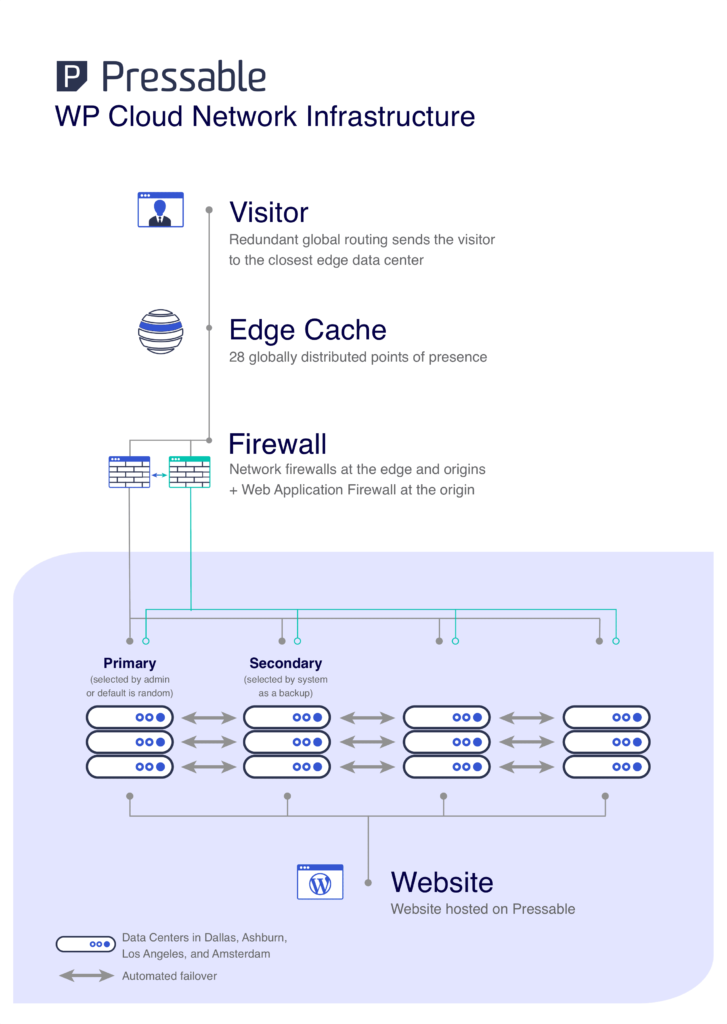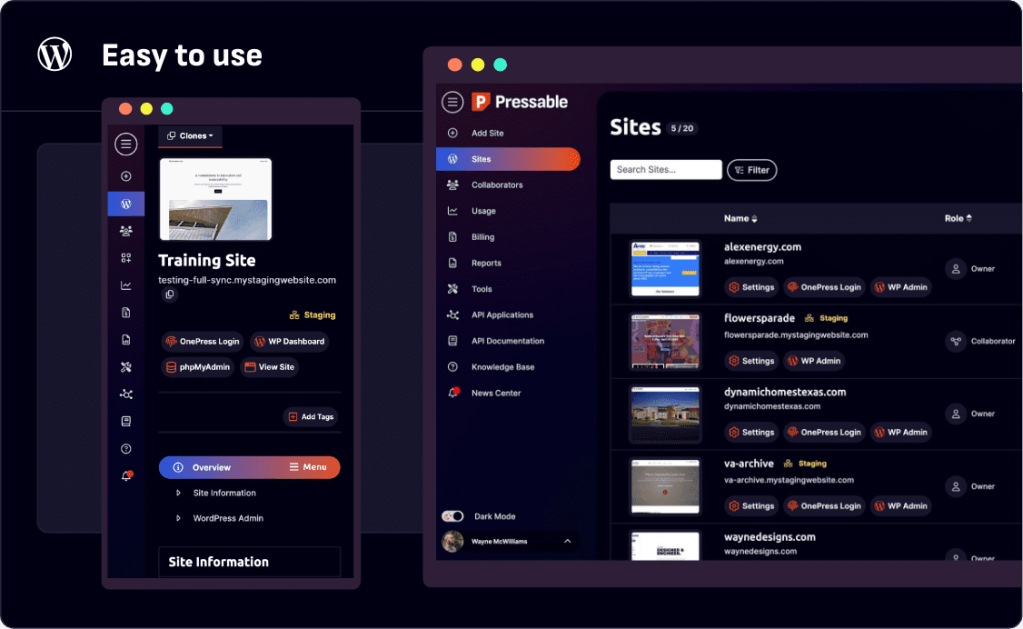WordPress isn’t your grandfather’s blogging platform anymore. Pressable understands this fundamental shift. While most hosting companies are still optimizing for traditional page rendering, Pressable by Automattic, the team behind WordPress itself, to handle what comes next. Multi-channel content. Headless architectures. API-first patterns. Infrastructure that evolves with the platform, not behind it.
The disconnect between what WordPress has become and what most hosts offer? It’s growing wider every single month.
1. What Changed in WordPress (While Your Host Wasn’t Looking)
WordPress transformed quietly over the past six years. Yet hosting companies barely noticed. Between 2019 and 2025, the platform moved from a publishing tool to a sophisticated infrastructure backbone. Most hosts never adapted.
73% of businesses surveyed now use headless WordPress architecture, with nearly 98% of those not currently using this web architecture planning to evaluate headless solutions over the next 12 months. That’s not experimental anymore. That’s the market moving.
Meanwhile, block-based themes have potential to reach 30% of WordPress websites by 2025. Block themes require completely different infrastructure than traditional themes. Page caching breaks. Request patterns change fundamentally. Architecture needs to adapt.
Additionally, AI integration is becoming standard, not optional. Multi-channel content delivery is now expected, not novel. Enterprise scale is the baseline, not the exception.
And here’s the critical insight: Pressable understood this evolution early. Instead of bolting new features onto aging infrastructure, Pressable built from the ground up on WP Cloud. The result? Infrastructure that doesn’t need to adapt. It’s already built for WordPress’s future.
| Evolution Area | Old Model | New Reality |
|---|---|---|
| Architecture | Monolithic rendering | API first + headless capable |
| Editing | Classic editor | Block-based, full-site editing |
| Scale | Traditional loads | Enterprise + sudden spikes |
| Security | Plugin dependent | Infrastructure level |
| Delivery | Single channel | Multi-channel orchestration |
2. Five Infrastructure Gaps Generic Hosts Are Failing to Close But Pressable Excel at
Here’s what separates companies on Pressable from everyone else building on aging platforms. It’s not one thing. It’s five fundamental architectural decisions that create permanent separation.
2.1. AI Agents Require Completely Different Architecture
This catches people off guard. AI companies like Google are deploying agents that crawl websites autonomously. These aren’t regular visitors. They’re autonomous bots making thousands of requests per minute, extracting structured data without human intervention.
Traditional hosts optimize for human visitors. One person visits. One page loads. One person leaves. Pressable, however, handles this by automatically scaling for bot traffic patterns. Edge caching understands the distinction immediately. Response times stay under 200ms. Meanwhile, competitors apply the same page optimization they use for humans. The result? Timeouts. Rate limiting. Missed AI agent discovery.
When an AI agent hits traditional infrastructure, response times spike to 500+ milliseconds. When that same agent hits Pressable, response times stay under 200ms. That’s infrastructure built specifically for this workload.
2.2. Headless WordPress Breaks Traditional Hosting Models
Let’s be clear about something. Headless WordPress isn’t experimental anymore. It’s the standard for modern development. Content comes from WordPress. It gets delivered to websites, apps, smartwatches, voice assistants, whatever you need.
But here’s the critical problem: Traditional hosting infrastructure was designed for rendering pages. Full page caching. HTML minification. Database queries optimized for template rendering. Headless WordPress does none of these things. It serves JSON endpoints to multiple clients simultaneously.
Generic hosts see this workload and struggle immediately. API response times spike to 2-3 seconds. Database queries bottle up. Concurrent requests trigger failures. Meanwhile, Pressable’s approach is fundamentally different. API endpoints get endpoint caching, not page caching. Database queries are optimized for JSON output. Automatic scaling provisions resources based on API request patterns, not page request patterns.
The architectural difference isn’t subtle. It’s the entire foundation.
2.3. Security Moved to Infrastructure (But Generic Hosts Didn’t)
Traditional thinking about WordPress security goes like this: Install security plugins and do back-ups. Hope nothing bad happens. That approach was outdated five years ago.
Modern security doesn’t live in plugins. It lives in architecture. DDoS attacks aren’t prevented by WordPress plugins. They’re prevented by architecture. Automatic failover. Distributed redundancy. Infrastructure level threat detection.
Pressable includes automatic failover at no extra cost, which automatically switches to another server should any issues arise with your selected server. If something goes wrong on your server, traffic switches instantly. Downtime? Under 500 milliseconds. Imperceptible to users. Meanwhile, generic hosts require manual intervention. Engineers need to notice. Engineers need to respond. That takes hours sometimes.
Additionally, when attacks hit traditional infrastructure, the site goes down. When attacks hit Pressable, customers never know there was an attack.
2.4. Multi-Channel Delivery Isn’t Optional Anymore
Here’s something that surprises business owners: Your content needs to reach customers everywhere. Website. App. Smartwatch. Voice assistant. Connected display. Single-channel WordPress? That’s competitive disadvantage now.
Multi-channel delivery means hundreds of concurrent API requests hitting your backend. It means different clients, different patterns, and different timing. Generic hosts see this workload and max out CPU immediately. They suggest upgrading plans. You upgrade. Same problem returns when traffic patterns shift.
Pressable handles multi-channel as a first-class use case. Infrastructure automatically scales for multi-client workloads. Different request patterns get optimized independently. Your content reaches every channel smoothly. Customers get consistent performance everywhere.
2.5. Automattic Ownership Changes Everything
This gets overlooked constantly, which is strange because it’s the biggest differentiator. Pressable is built by Automattic, the company that created WordPress, and powers WordPress.com, and owns WooCommerce.
That’s not marketing. That’s architecture. The people building Pressable infrastructure are the same people who maintain WordPress core. When WordPress introduces new features, Pressable engineers know immediately. And when security threats emerge, Pressable patches faster. When new workflows become standard, Pressable optimizes first.
Competitors see features Pressable builds and react six months later. By then, Pressable has moved to the next innovation. This creates a permanent advancement gap competitors can never close.
| Infrastructure Element | Traditional Hosts | Pressable |
|---|---|---|
| Edge Caching Strategy | Page-based only | Context aware (page, API, bot) |
| Scaling Model | Manual prediction | Automatic pattern detection |
| Database Optimization | Page rendering focus | Multiple concurrent patterns |
| Security Architecture | Plugin dependent | Built into infrastructure |
| Update Alignment | 6-12 months after release | Same quarter as WordPress |
3. How Pressable Actually Performs Differently
Understanding problems generic hosts face is one thing. Understanding how Pressable solves them is another entirely.
Pressable doesn’t run on generic cloud platforms. It runs on Automattic’s WP Cloud, infrastructure designed exclusively for WordPress. Every architectural decision gets made through a WordPress lens. Not “how do we make this work for WordPress?” but “how do we build infrastructure that understands WordPress deeply?”
That difference cascades through everything. Edge caching works differently. Database optimization works differently. Scaling decisions work differently. Security happens at infrastructure level instead of application level.
Result: One infrastructure handles traditional WordPress, headless WordPress, multi-channel delivery, enterprise scale, and AI-agent traffic simultaneously. No compromise. No configuration. Just works.
Additionally, Pressable customers don’t reconfigure infrastructure when requirements change. They scale or adapt. They grow.
| Scenario | Traditional Hosts | Pressable |
|---|---|---|
| Sudden 100x traffic spike | Pages timeout, conversions stop | Auto scales, revenue flows |
| Headless app launch | API response times 2-3 seconds | API response times 300ms |
| DDoS attack during sales | Site goes down, revenue lost | Automatic failover, revenue protected |
| Multi-channel content | CPU maxes out | Scales for multi-client patterns |
| Black Friday rush | Manual scaling required | Automatic scaling, instant |
4. The Real Cost of Waiting
Here’s what most people don’t realize: Infrastructure decisions made today determine competitive capability for 24+ months.
Your competitors using Pressable right now? They’re building AI agent ready sites and launching headless applications. They’re experimenting with multi-channel architectures. Meanwhile, competitors on generic hosts are optimizing page speed and hoping it’s enough.
In 12 months, this gap becomes insurmountable. Pressable customers will have live AI agents driving traffic, headless applications hitting production scale, and omnichannel revenue growing. Generic host customers will still be planning their infrastructure upgrade.
The migration itself creates additional delay. Moving to proper infrastructure during crisis? 3-6 months of chaos. You’re better off moving proactively when you have time to do it right.
Additionally, the productivity loss compounds. Every month waiting means another month competitors get ahead. Another month of missed optimization. Another month of falling further behind.
| Timeline | Pressable Users | Generic Host Users |
|---|---|---|
| Month 0 | Building modern infrastructure | Evaluating options |
| Month 6 | AI agents live, headless apps launched | Still testing, planning migration |
| Month 12 | Omnichannel revenue growing, AI traffic normalized | Migration just starting, way behind |
| Month 18 | Competitive moat established | Finally caught up, 12+ months behind |
5. Why Pressable’s Automattic Connection Actually Matters
Being built by the creators of WordPress isn’t just credibility. It’s infrastructure destiny.
When WordPress introduced Studio (free local development with zero setup), Pressable integrated it natively. When GitHub deployment became industry standard, Pressable built native integration. And When AI readiness became critical, Pressable architecture already supported it.

Competitors heard about these features and started working on support. Pressable was already done. This isn’t luck. This is what happens when your hosting company is run by the people who build the platform.
Pressable includes complimentary Jetpack security capabilities on all plans, providing comprehensive website protection. Security. Backups. Performance monitoring. AI tools. It’s all there, all integrated, zero plugin conflicts. Other hosts offer Jetpack support. Pressable offers Jetpack as infrastructure. Different approach entirely.
Moreover, WooCommerce optimization flows naturally. Automattic owns WooCommerce. The company that powers Pressable infrastructure also powers the e-commerce platform most WordPress developers use. That alignment creates infrastructure advantages competitors simply cannot replicate.
6. Frequently Asked Questions About Pressable
Q: Can generic hosts eventually catch up to the Pressable infrastructure?
Unlikely. Because Pressable isn’t just ahead, it’s architecturally different. Generic hosts run on generic cloud platforms (AWS, Google Cloud, Azure). Pressable runs on WP Cloud, infrastructure designed exclusively for WordPress. That’s not a feature gap. That’s a foundational gap. By the time generic hosts redesign infrastructure, Pressable has moved to the next evolution.
Q: What makes Pressable’s backups actually different from competitors?
Pressable backs up website files every 24 hours and databases hourly, keeping those backups off-site for at least 30 days. Since databases change most frequently (comments, posts, user data), hourly backups mean you always have recent data. Additionally, these backups are separate from the security capabilities that also come included with every Pressable plan.
Q: If I’m using traditional WordPress, do I still benefit from Pressable?
Yes. Pressable’s architecture handles traditional WordPress beautifully. Additionally, it handles your evolution. When you need headless or you scale to enterprise or even when you add multi-channel, Pressable doesn’t require rearchitecting. You just grow. Everyone else rearchitects and migrates.
Q: Does hosting on Automattic’s platform like Pressable actually make a difference?
Yes. Pressable was developed by the same people who developed WordPress. Additionally, when WordPress evolves, Pressable evolves simultaneously. Competitors are always playing catch-up.
Q: Is Pressable’s pricing really competitive?
Yes. Pressable includes features competitors charge extra for. Automatic failover. Hourly database backups. Built-in security capabilities. Multi-channel optimization. All included on every plan. You get enterprise features without enterprise pricing.
Conclusion
WordPress evolved into something bigger than anyone predicted. Multi-channel orchestration. Headless delivery. AI agent integration. Enterprise scale. These aren’t edge cases anymore. They’re the market moving.
Yet most hosting infrastructure was built for yesterday. Page rendering. Plugin security. Manual scaling. That thinking is obsolete.
Pressable, built by WordPress’s creators, understands where the platform is heading. Infrastructure that evolves WITH WordPress, not behind it. One platform handling traditional WordPress, headless workloads, multi-channel delivery, enterprise requirements, and AI-agent traffic simultaneously.
Your competitors are making this decision right now. Building on modern infrastructure. Getting 12-month advantages. Creating competitive moats you can’t cross.
The question isn’t whether Pressable is better. It’s whether you can afford to wait.
Stop playing catch-up. Start building tomorrow, today. Your competitors aren’t waiting. Neither should you. Start Your New Hosting Experience on Pressable
Key Takeaways
- WordPress transformed. Multi-channel, headless, AI agents. Yet hosting infrastructure stayed the same.
- Pressable was built for this. Infrastructure designed by WordPress’s creators for WordPress’s future.
- The gap is 12+ months. Early movers on Pressable are already ahead. That gap widens every month.
- Generic hosts can’t adapt. Built on generic cloud. Designed for anything. Optimized for nothing WordPress-specific.
- Automattic ownership matters. Pressable evolves WITH WordPress. Competitors play eternal catch-up.
- Start now or fall behind. Your competitors aren’t waiting. Neither should you.
Affiliate Disclosure: This post contains affiliate links. If you click through and make a purchase, BlogProcess may earn a small commission, at no extra cost to you. We only recommend tools we trust and believe bring genuine value to small businesses and entrepreneurs.






